In Photos: New Human Relative Shakes Up Our Family Tree
An international team of scientists has discovered the remains of
what they say belong to a completely new species of human. The bones
were found in a cave in South Africa and may change our view on the dawn
of humanity. Here's a look at photos of the discovery, some of which
are from the October issue of National Geographic magazine. [Read the full story on the human species discovery]
Human star
The
scientists involved, including lead author Lee Berger of the University
of the Witwatersrand in Johannesburg, have named the newfound species Homo naledi
— "naledi" means "star" in Sotho (also called Sesotho), one of the
languages spoken in South Africa. The bones were discovered in what has
been named the Dinaledi chamber within the Rising Star cave system, in
South Africa's Cradle of Humankind. Paleoartist John Gurch spent some
700 hours recreating the head of Homo naledi based on bone scans. (Photo Credit: Mark Thiessen/National Geographic)
Little brain
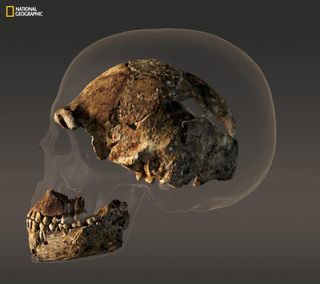
H. naledi
would have sported a similar body mass and size to small-bodied human
populations, but its brain was relatively smaller, with its endocranial
volume (a proxy for brain size) more similar to the australopiths, or
members of the Australopithecus genus, the researchers found.
Shown
here, the braincase of a composite male skull, measuring 34 cubic
inches (560 cubic centimeters), with the modern human skull pictured in
the background. (Image Credit: Stefan Fichtel. Sources: Lee Berger and
Peter Schmid, Wits; John Hawks, University of Wisconsin-Madison/National
Geographic)
Comparing skeletons

Here a composite skeleton of the overall body plan of H. naledi, along with an illustration showing how it compares with Homo species
such as H. erectus and australopithecines such as Lucy. (Photo Credit:
Skeleton: Stefan Fichtel/National Geographic Body Comparison Painting:
John Gurche; Sources: Lee Berger and Peter Schmid, Wits; John Hawks,
University of Wisconsin-Madison)
Cave chutes
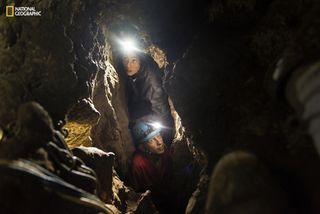
By studying the remains, the researchers found evidence that individuals of H. naledi
seemed to have intentionally placed the bodies of their dead into this
remote cave chamber; this behavior was previously thought to be limited
to modern humans. Here, lead researcher Lee Berger's daughter, Megan,
who is acting as a safety caver on the expedition, and underground
exploration team member Rick Hunter navigate the narrow chutes leading
to the Dinaledi chamber where fossil specimens belonging to the new
species were discovered. (Photo Credit: Robert Clark/National
Geographic)
Arranging a skeleton
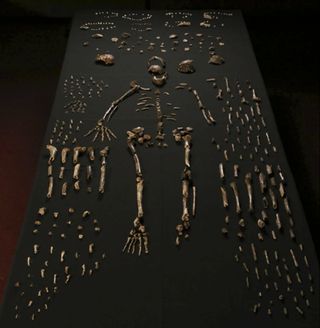
Berger
and his colleagues unearthed fossils from at least 15 individuals, with
multiple specimens for most of the bones in the skeleton. The species
would have been equipped with tree-climbing hands and ground-walking
feet. (Photo Credit: Berger et al. eLife 2015;4:e09560. DOI:
10.7554/eLife.09560, Creative Commons)
Homo hand
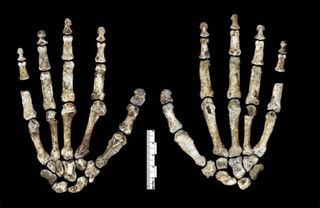
"While
the skull had several unique features, it had a small braincase that
was most similar in size to other early hominin species that lived
between 4 million and 2 million years ago," the researchers wrote in the
journal eLife. "Homo naledi's ribcage, shoulders and pelvis also more
closely resembled those of earlier hominin species than those of modern
humans." Here, the hand of the newfound species, found articulated, the
researchers said.
Human looks
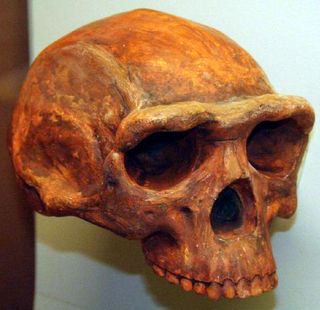
Though H. naledi is unique, the researchers note the species is most similar to early Homo species including Homo erectus, whose skull is shown here, Homo habilis or Homo rudolfensis. (Photo Credit: Thomas Roche | Wikimedia Commons)
Cover story
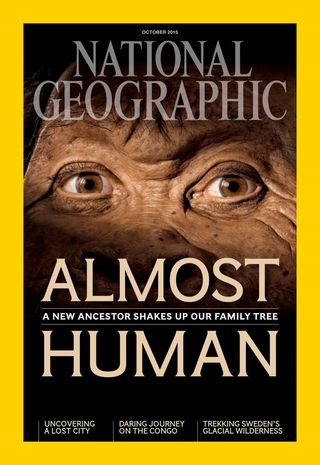
The discovery of Homo naledi is the cover story for the October issue of National Geographic magazine. (Photo Credit: Mark Thiessen/National Geographic)
Campsite
Campsite in South Africa where National Geographic Exp
lorer-in-Residence Lee
Berger of the University of Witwatersrand led an exped
ition to recover the
remains of
H. naledi
, a new species of human relative. The find was announced
by
the University of the Witwatersrand, the National Ge
ographic Society and the
South African National Research Foundation and publish
ed in the journal eLife.
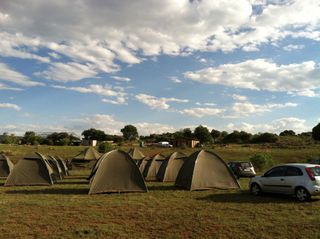
Campsite
in South Africa where National Geographic Explorer-in-Residence Lee
Berger of the University of Witwatersrand led an expedition to recover
the remains of H. naledi, a new species of human relative. The find was
announcedbythe University of the Witwatersrand, the National Geographic
Society and the South African National Research Foundation and published
in the journal eLife. (Photo Credit: Andrew Howley/National Geographic)
Underground astronauts
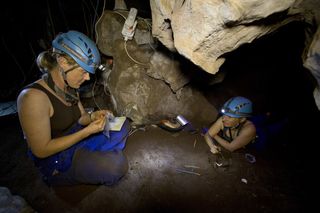
Getting
into the Dinaledi chamber in the Rising Star cave meant climbing up a
steep limestone block called the Dragon's Back and then a descent down a
narrow crack just 7 inches (18 centimeters) wide. A global call for
researchers who could fit through the narrow opening resulted in six
women who would serve as "underground astronauts." Here, two underground
astronauts, Marina Elliott and Becca Peixotto, work inside the cave
where fossils of H. naledi were discovered. (Photo Credit: Garreth Bird)
Nenhum comentário:
Postar um comentário
Observação: somente um membro deste blog pode postar um comentário.